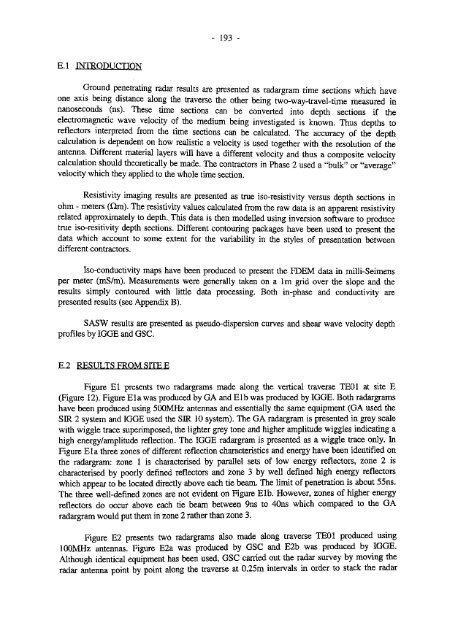site characterisation study - phases 1 and 2 - HKU Libraries - The ...
site characterisation study - phases 1 and 2 - HKU Libraries - The ...
site characterisation study - phases 1 and 2 - HKU Libraries - The ...
- No tags were found...
You also want an ePaper? Increase the reach of your titles
YUMPU automatically turns print PDFs into web optimized ePapers that Google loves.
- 193 -E.I INTRODUCTIONGround penetrating radar results are presented as radargram time sections which haveone axis being distance along the traverse the other being two-way-travel-time measured innanoseconds (ns). <strong>The</strong>se time sections can be converted into depth sections if theelectromagnetic wave velocity of the medium being investigated is known. Thus depths toreflectors interpreted from the time sections can be calculated. <strong>The</strong> accuracy of the depthcalculation is dependent on how realistic a velocity is used together with the resolution of theantenna. Different material layers will have a different velocity <strong>and</strong> thus a compo<strong>site</strong> velocitycalculation should theoretically be made. <strong>The</strong> contractors in Phase 2 used a "bulk" or "average 59velocity which they applied to the whole time section.Resistivity imaging results are presented as true iso-resistivity versus depth sections inohm - meters (Dm). <strong>The</strong> resistivity values calculated from the raw data is an apparent resistivityrelated approximately to depth.. This data is then modelled using inversion software to producetrue iso-resitivity depth sections. Different contouring packages have been used to present thedata which account to some extent for the variability in the styles of presentation betweendifferent contractors.Iso-conductivity maps have been produced to present the FDEM data in milli-Seimensper meter (mS/m). Measurements were generally taken on a lm grid over the slope <strong>and</strong> theresults simply contoured with little data processing. Both in-phase <strong>and</strong> conductivity arepresented results (see Appendix B).SASW results are presented as pseudo-dispersion curves <strong>and</strong> shear wave velocity depthprofiles by IGGE <strong>and</strong> GSC.E.2 RESULTS FROM SITE EFigure El presents two radargrams made along the vertical traverse TE01 at <strong>site</strong> E(Figure 12). Figure El a was produced by GA <strong>and</strong> Elb was produced by IGGE. Both radargramshave been produced using 500MHz antennas <strong>and</strong> essentially the same equipment (GA used theSIR 2 system <strong>and</strong> IGGE used the SIR 10 system). <strong>The</strong> GA radargram is presented in grey scalewith wiggle trace superimposed, the lighter grey tone <strong>and</strong> higher amplitude wiggles indicating ahigh energy/amplitude reflection. <strong>The</strong> IGGE radargram is presented as a wiggle trace only. InFigure El a three zones of different reflection characteristics <strong>and</strong> energy have been identified onthe radargram: zone 1 is characterised by parallel sets of low energy reflectors, zone 2 ischaracterised by poorly defined reflectors <strong>and</strong> zone 3 by well defined high energy reflectorswhich appear to be located directly above each tie beam. <strong>The</strong> limit of penetration is about 55ns.<strong>The</strong> three well-defined zones are not evident on Figure Elb. However, zones of higher energyreflectors do occur above each tie beam between 9ns to 40ns which compared to the GAradargram would put them in zone 2 rather than zone 3.Figure E2 presents two radargrams also made along traverse TE01 produced using100MHz antennas. Figure E2a was produced by GSC <strong>and</strong> E2b was produced by IGGE.Although identical equipment has been used, GSC carried out the radar survey by moving theradar antenna point by point along the traverse at 0.25m intervals in order to stack the radar
















